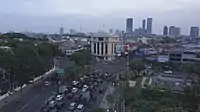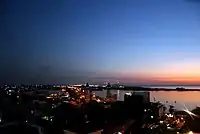List of Indonesian cities by population
Below is a list of Indonesia's cities with their rank and population. Population in 2010 is official data from 2010 Census released by Badan Pusat Statistik or Indonesian Central Statistics Agency.[1] Population in 2015 is official data from the 2015 Inter-Census Survey, also as released by the Central Statistics Agency.
Cities proper by population
| This article is part of a series on |
| Subdivisions of Indonesia |
|---|
| Level 1 |
|
| Level 2 |
| (Full list; GDP; population) |
| Level 3 |
|
| Level 4 |
|
The Indonesian law defines a city (kota) as a second-level administrative subdivision of the country, similar to regency (kabupaten). The difference between a regency and a city lies in demography, size, and economy. Generally, a city has non-agricultural economic activities, while a regency comprises a rural area larger than a city. A city is headed by a mayor (walikota).
An administrative city is a city without its own local legislatures (Dewan Perwakilan Rakyat Daerah). The mayor of an administrative city is directly appointed by the Governor. This type of city in Indonesia is only found in Jakarta Province, formerly a municipal city, which consisted of 5 administrative cities and 1 administrative regency.[2]
- Bold: province's capital city
- Italics: province's largest city
Top ten largest urban centres
The followings are the largest core cities in Indonesia (excluding satellite cities):
| Ranking | City | Region | Population | Image |
|---|---|---|---|---|
| 1 | Jakarta | Jakarta | 10,075,310 |  |
| 2 | Surabaya | East Java | 3,009,800 |  |
| 3 | Bandung | West Java | 2,575,478 |  |
| 4 | Medan | North Sumatera | 2,241,890 |  |
| 5 | Semarang | Central Java | 2,067,254 |  |
| 6 | Palembang | South Sumatera | 1,455,284 |  |
| 7 | Makassar | South Sulawesi | 1,337,800 |  |
| 8 | Batam | Riau Islands | 1,290,890 |  |
| 9 | Pekanbaru | Riau | 1,104,112 |  |
| 10 | Bandar Lampung | Lampung | 1,015,910 |  |
Built-up urban areas
The followings are the contiguous urban areas in Indonesia, with a population of over one half million, according to Demographia's "World Urban Areas" study. Demographia defines an urban area (urbanised area agglomeration or urban centre) as a continuously built up land mass of urban development that is within a labor market (metropolitan area), without regard for administrative boundaries (city).[6]
| Rank | Urban area | Area (km2) |
Estimated population[6] |
|---|---|---|---|
| 1 | Jakarta | 3,540 | 34,540,000 |
| 2 | Bandung | 487 | 7,065,000 |
| 3 | Surabaya | 911 | 6,499,000 |
| 4 | Medan | 478 | 3,632,000 |
| 5 | Semarang | 259 | 1,992,000 |
| 6 | Makassar | 178 | 1,952,000 |
| 7 | Palembang | 221 | 1,889,000 |
| 8 | Yogyakarta | 230 | 1,568,000 |
| 9 | Malang | 212 | 1,493,000 |
| 10 | Denpasar | 177 | 1,389,000 |
| 11 | Batam | 243 | 1,362,000 |
| 12 | Pekanbaru | 239 | 1,118,000 |
| 13 | Surakarta | 477 | 1,106,000 |
| 14 | Cirebon | 105 | 1,017,000 |
| 15 | Bandar Lampung | 107 | 978,000 |
| 16 | Samarinda | 102 | 960,000 |
| 17 | Padang | 99 | 796,000 |
| 18 | Banjarmasin | 65 | 710,000 |
| 19 | Tasikmalaya | 62 | 671,000 |
| 20 | Pontianak | 62 | 660,000 |
| 21 | Balikpapan | 124 | 645,000 |
| 22 | Jambi city | 78 | 595,000 |
| 23 | Serang | 65 | 585,000 |
| 24 | Cilegon | 122 | 525,000 |
References
- "Sensus Penduduk 2010". Badan Pusat Statistik. Retrieved 5 April 2017.
- "Profil Daerah (Regional profiles)". Indonesian Ministry of Interior.
- https://www.citypopulation.de/Indonesia.html
- https://www.citypopulation.de/Indonesia.html
- 2015 Inter-census Survey by Badan Pusat Statistik, Jakarta.
- "Demographia World Urban Areas, 16th Annual Edition" (PDF). February 2020. Archived from the original (PDF) on 7 February 2020. Retrieved 24 June 2020.
